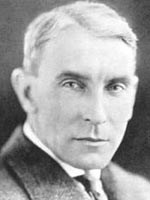
Tom Campbell grew up on an 80 acre farm with a sod homestead in eastern North Dakota. Day after grueling day he worked alongside his family farming the land with a team of oxen and cradle. It was the thought of this drudgery which pushed Campbell into becoming one of the most innovative corporate farmers in American history. The land where he made some of his greatest achievements can still be seen today, looking out from the Ok-A-Beh Road. Food Would Win the War He selected four large tracts of land on the Shoshone, Blackfoot, Fort Peck, and Crow Indian reservations in Montana and Wyoming. One of the main stipulations of such an agreement was that the tribes would receive ten percent of the crop’s cash value. The Crow lands Campbell selected were bench land on the western side of the Bighorn River and south of Beauvais Creek. Campbell secured investment capital of two million dollars from the House of Morgan for his enterprise. The Campbell Farming Corporation was thus formed. Bumper Crops to the Verge of Bankruptcy Over the next seven years each crop proved profitable. In 1922, a bumper crop yielded half a million bushels of wheat, nearly ten times the yield during the drought years. Unfortunately, the Great Depression hit Campbell hard. By 1932, due to falling prices, he was on the verge of bankruptcy. The passage of New Deal farming legislation by the administration of President Franklin Roosevelt arrived just in time for Campbell to recoup his losses. Unprecedented Success Campbell continued to innovate, using aerial spraying for grasshopper and weed control. This allowed even marginal fields to become highly profitable. By the late 1940s, the corporation was using 78 foot plows and had 65,000 acres under lease. One-third of the land would be cultivated, while the other two-thirds lay fallow or uncultivated. Campbell’s success did not come without criticism. Some saw him as a symbol of corporate greed, while others thought him nothing more than a land baron. Yet Campbell’s innovations and success made him world famous. Perhaps the Crow people best described Campbell when they gave him the name, Ahwagoda-Agoush, translated to English this means, “Known all over the World.” |
Last updated: February 24, 2015
